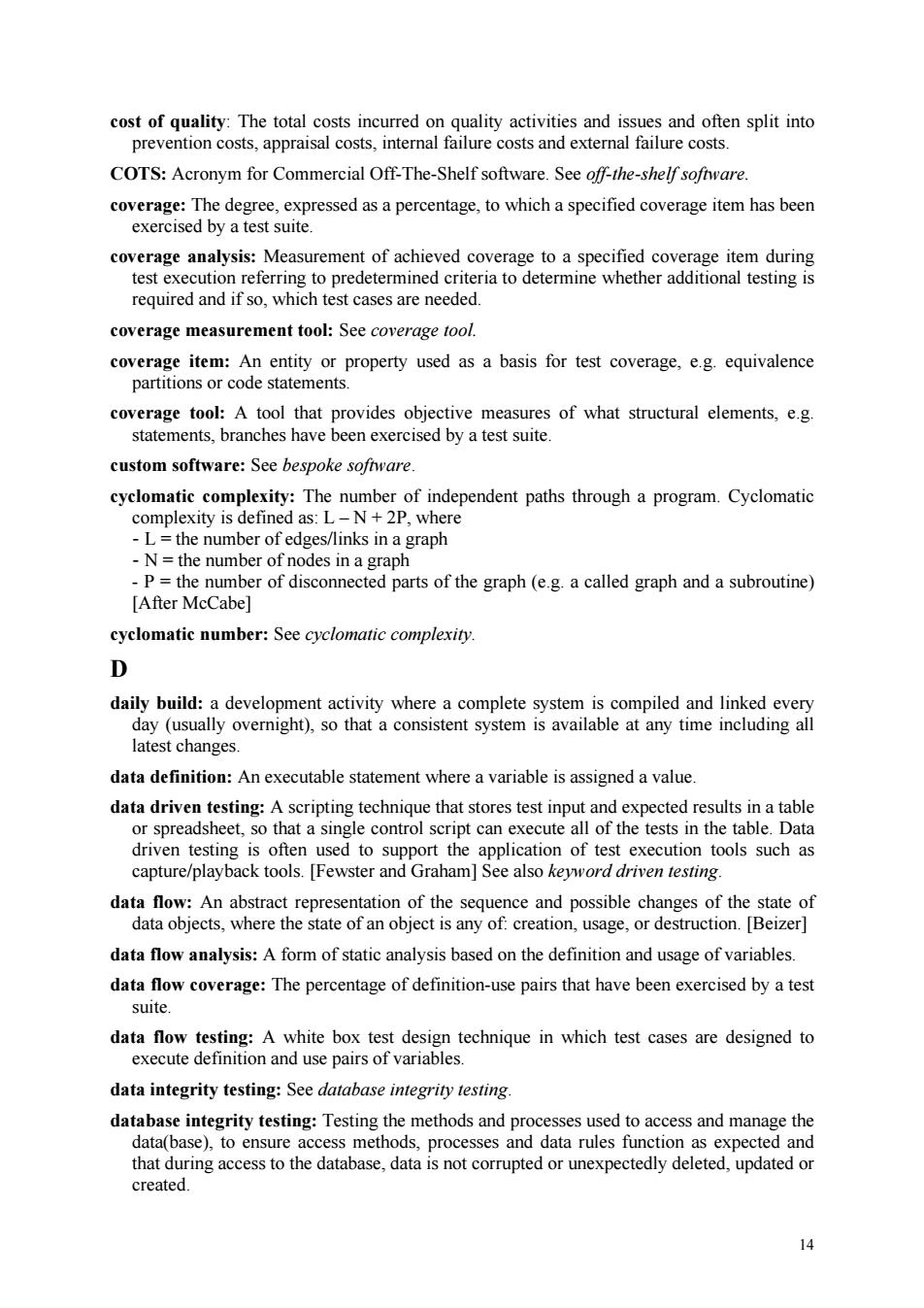正在加载图片...

cost of quality:The total costs incurred on quality activities and issues and often split into prevention costs,appraisal costs,internal failure costs and external failure costs. COTS:Acronym for Commercial Off-The-Shelf software.See fthe-shelfsofware. coverage analysis:Measurement of achieved coverage to a specified coverage item during test execution referring to predetermined criteria to determine whether additional testing is required and if so,which test cases are needed. coverage measurement tool:See coverage tool. coverage tool:A tool that provides objective measures of what structural elements,e.g. statements,branches have been exercised by a test suite. custom software:See bespoke software. eyelomatic my:The number of independent paths through a program.Cyclomatic compl er of edges/links in a graph 0 d parts of the graph (e.g.a called graph and a subroutine) IAfter McCabel cyclomatic number:See cvclomatic complexity daily build:a devel at a a eo mplete s day (usually o con ent em is ny time e including all latest changes. data definition:An executable statement where a variable is assigned a value. data driven testing:A scripting technique that stores test input and expected results in a table sheet so that a single control script can cute all of the test in the table. a capture/playback tools.Fewster and GrahamSee also keyorddiven esng ng sed to sup executio n tools such as data flow:An abstractr esentation of the sequence and possible changes of the state of data flow analysis:A form of static analysis based on the definition and usage of variables. data flow coverage:The percentage of definition-use pairs that have been exercised by a test suite. data integrity testing:See database integrity testing database integrity testing:Testing the methods and processes used to access and manage the data(base),to ensure access methods,processes and data rules function as expected and that during access to the database,data is not corrupted or unexpectedly deleted,updated or created.14 cost of quality: The total costs incurred on quality activities and issues and often split into prevention costs, appraisal costs, internal failure costs and external failure costs. COTS: Acronym for Commercial Off-The-Shelf software. See off-the-shelf software. coverage: The degree, expressed as a percentage, to which a specified coverage item has been exercised by a test suite. coverage analysis: Measurement of achieved coverage to a specified coverage item during test execution referring to predetermined criteria to determine whether additional testing is required and if so, which test cases are needed. coverage measurement tool: See coverage tool. coverage item: An entity or property used as a basis for test coverage, e.g. equivalence partitions or code statements. coverage tool: A tool that provides objective measures of what structural elements, e.g. statements, branches have been exercised by a test suite. custom software: See bespoke software. cyclomatic complexity: The number of independent paths through a program. Cyclomatic complexity is defined as: L – N + 2P, where - L = the number of edges/links in a graph - N = the number of nodes in a graph - P = the number of disconnected parts of the graph (e.g. a called graph and a subroutine) [After McCabe] cyclomatic number: See cyclomatic complexity. D daily build: a development activity where a complete system is compiled and linked every day (usually overnight), so that a consistent system is available at any time including all latest changes. data definition: An executable statement where a variable is assigned a value. data driven testing: A scripting technique that stores test input and expected results in a table or spreadsheet, so that a single control script can execute all of the tests in the table. Data driven testing is often used to support the application of test execution tools such as capture/playback tools. [Fewster and Graham] See also keyword driven testing. data flow: An abstract representation of the sequence and possible changes of the state of data objects, where the state of an object is any of: creation, usage, or destruction. [Beizer] data flow analysis: A form of static analysis based on the definition and usage of variables. data flow coverage: The percentage of definition-use pairs that have been exercised by a test suite. data flow testing: A white box test design technique in which test cases are designed to execute definition and use pairs of variables. data integrity testing: See database integrity testing. database integrity testing: Testing the methods and processes used to access and manage the data(base), to ensure access methods, processes and data rules function as expected and that during access to the database, data is not corrupted or unexpectedly deleted, updated or created